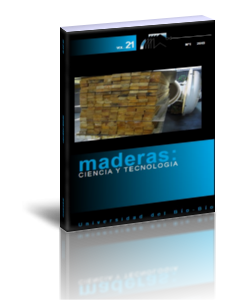Stability of planed and precision planed solid wood surfaces due to wetting
Keywords:
Cutting parameters, deformation zone, planed surface, roughness, surface stabilityAbstract
The upper cell layers of machined solid wood surfaces will usually be damaged and compacted due to cutting forces. The deformation zone may be instable due to temperature and moisture variations as a consequence of artificial surface treatment or environmental interaction. Therefore, an evaluation method of surface stability in this respect would be desirable.
In the frame of the new developed surface roughness evaluation method an individual wetting procedure has been developed, whilst surfaces have been characterized by 3D roughness measurement. The stability of surfaces is characterized by appropriate roughness ratios measured before and after wetting. The core depth Sk of the Abbott parameters is the most sensitive indicator to any changes in the deformation zone. Different machining processes may produce surfaces with different stability but wood species have also definite influence on the surface stability, probably due to their density and moisture conduction properties. Latter is supported by the fact that the half-time of moisture evaporation from surfaces may differ considerably. In these experiments, planed and precision-planed surfaces were compared. According to the working principle of the precision planers the planing tool is held stationary whilst the work piece does the feeding motion, thus the blade produces a very thin slice. Using this machine, the machining roughness can be reduced to minimum as it is possible to avoid formation of cycloid arcs (like in case of traditional planing) and also possible to avoid dust formation (like in case of sanding).
Investigations were conducted on Norway spruce (Picea abies), larch (Larix decidua), scots pine (Pinus sylvestris), sessile oak (Quercus petraea), black locust (Robinia pseudoacacia), aspen (Populus tremula) and beech (Fagus sylvatica). Black locust and the sessile oak have had most stable surfaces by both machining methods. The deformation zone of precision planed surfaces has been proven to be more stable than the one of planed surfaces for all wood species.
Downloads
References
Csanády, E.; Magoss, E. 2013. Mechanics of wood machining. Berlin: Springer-Verlag p.199.
Csanády, E.; Magoss, E.; Tolvaj, L. 2015. Quality of Machined Wood Surface. Berlin: Springer-Verlag p.257.
Csiha, Cs.; Gurau, L. 2011. Study on the influence of surface roughness on the adhesion of water based PVAC. In: Proceedings of International Conference “Wood Science and Engineering”, Brasov, Romania, pp 411-419.
Dong, W.P.; Sullivan, P.J.; Stout, K.J. 1994. Comprehensive study of parameters for characterising three-dimensional surface topography: III: Parameters for characterising amplitude and some functional properties. Wear 178(1-2): 29-43.
International Organization for Standardization. ISO. 2012. Geometrical product specifications (GPS). Surface texture. Areal. Terms, definitions and surface texture parameters. ISO 25178-2:2012. < https://www.iso.org/standard/42785.html > (Accessed 08.11.2018)
Fischer, R.; Schuster, C. 1993. Qualitäts entstehung spannend erzeugter Holzoberflächen. Institute für Holztechnik. TU: Dresden, pp. 28-32.
GFMesstechnik. GFM. 2008. MikroCAD Optical 3D-measuring Instrument. Software ODSCAD 6.0. Handbook
Gottlöber, C. 2014. Zerspanung von Holz und Holzwerkstoffen: Grundlagen - Systematik - Modellierung - Prozessgestaltung. Fachbuchverlag Leipzig im Carl Hanser Verlag: München.
Gurau, L.; Irle, M. 2017. Surface Roughness Evaluation Methods for Wood Products: a Review. Curr Forestry Rep 3(2): 119-131.
Laina, R.; Sanz-Lobera, A.; Villasante A.; López-Espí, P.; Martínez-Rojas, J. A.; Alpuente, J.; Sánchez-Montero, R.; Vignote, S. 2017. Effect of the anatomical structure, wood properties and machining conditions on surface roughness of wood. Maderas-Cienc Tecnol 19(2): 203 - 212.
Malkoçoğlu, A. 2007. Machining properties and surface roughness of various wood species planed in different conditions. Building and Environment 42 (7): 2562-2567.
Molnár, Zs.; Magoss, E.; Fuchs, I.; Rosta, T. 2015. Einfluss von Bearbeitung und Befeuchtung auf die Oberflächentopologie von Vollholz. Holztechnologie 56(2): 10-19.
Molnár, Zs.; Magoss, E.; Fuchs, I.; Csiha, Cs. 2017. Stability of thermosmoothed and precision planed solid wood surfaces. J. Wood Product 76(1): 243-249.
Westkämper, E.; Riegel, A.; Kisselbach, A.; Schadoffsky, O. 1997. Gefügeschädigungen als Standzeitkriteriu. Teil I. Holz- und Kunststoffverarbeitung 32(9): 47-49.
Westkämper, E.; Riegel, A.; Kisselbach, A.; Schadoffsky, O. 1997. Gefügeschädigungen als Standzeitkriterium? Teil II. Holz- und Kunststoffverarbeitung 32(10):43-45.
Westkämper, E.; Riegel, A.; Kisselbach, A.; Schadoffsky, O. 1997. Gefügeschädigungen als Standzeitkriterium? Teil III. Holz- und Kunststoffverarbeitung 32(11): 80-82.

































